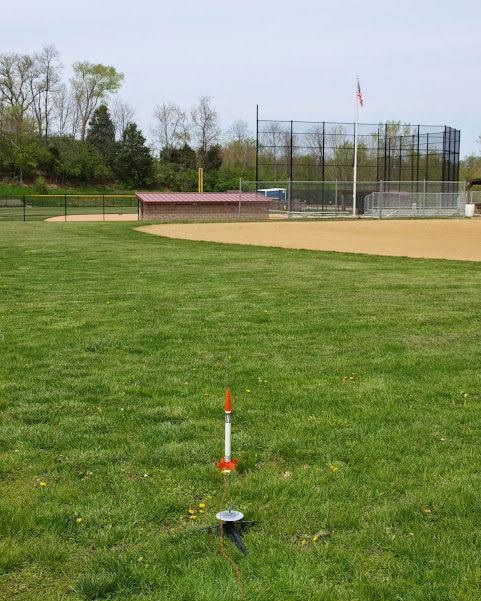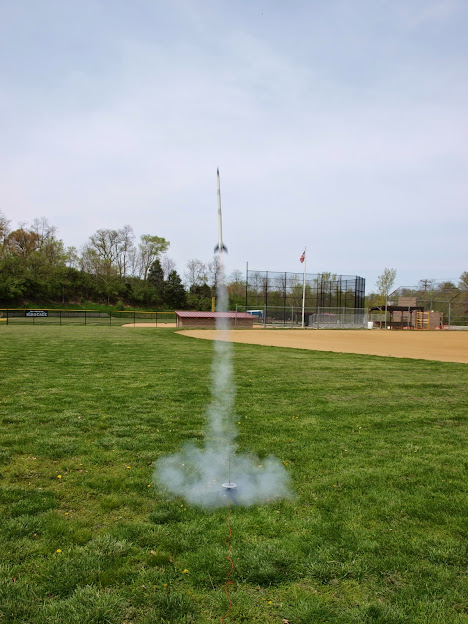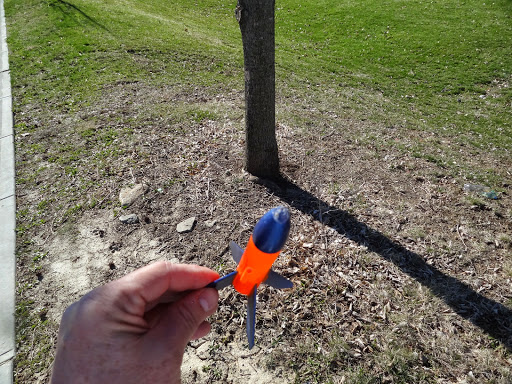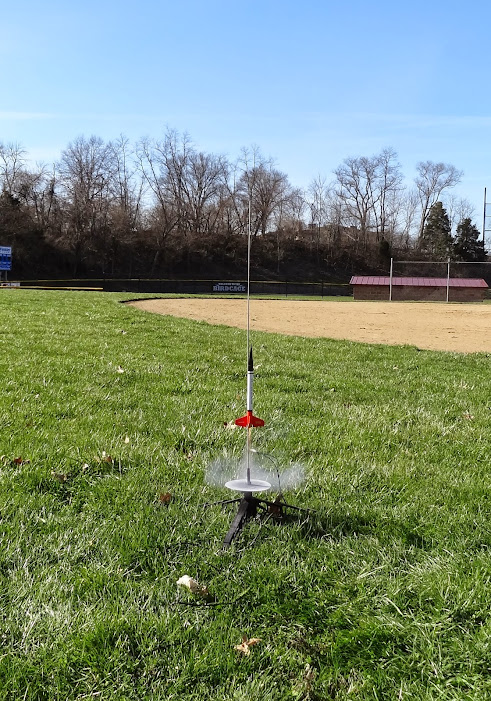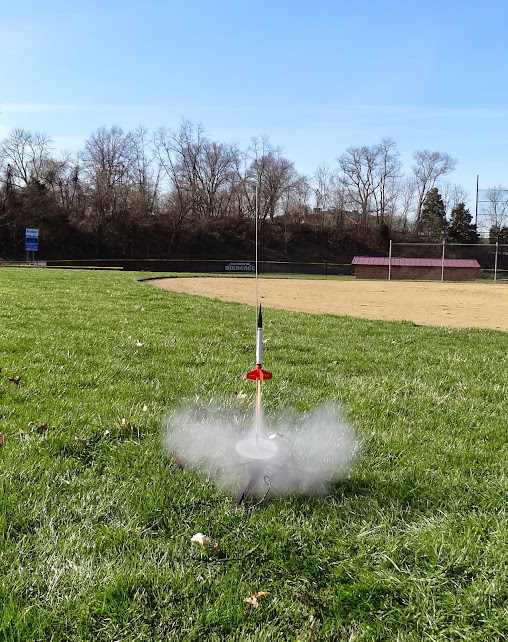Wednesday, April 1 looked like it would be the last nice day before the April Showers took control of the B6-4 Field weather system. It was also the middle of the spring break week for the city schools, so I knew the field would more than likely be empty. With that in mind I spent a half hour making sure I had everything necessary for a quick launch, loaded the car, and headed for the field. When I returned ten minutes later to pick up the RANGE BOX that had the LAUNCH PAD and LAUNCHER, I decided that in the future I'd need some sort of checklist. (Shakes head sadly knowing there will be no checklist.)
As expected, I had the run of the field, and unlike Tuesday, winds were light enough to be negligible. I set up in deep in the hole at shortstop, more outfield than infield. The flag over the Highlands girls softball field fluttered harmlessly. I'd chosen wisely. It's a well known fact that April 1st is the birthday of rocket deity Don Magness, head nut at Squirrel Works Rocketry. In Don's honor I'd decided to make my recently repaired Squirrel Works Red Baron the first rocket off the pad. Having actually checked to see that I had a B4-2 in the range box, and having just as recently trimmed the Baron for flight after a rebuild, I expected a memorable flight. Memorable. Yeah, we'll go with that.

The plan was to get the shakedown flight in, then go home and touch up the paint from the recent repairs, and finally add the decals. I was pumped. The B4-2 fit into the engine tube without tape, which I took as a good sign. Clearly I had done something right. I loaded the Baron on the pad, hooked up the clips to a new Estes "starter", took the obligatory glamour shot, checked the camera for burst mode, and pressed the button. The burst mode rang off ten quick shots while the Baron sat on the pad. Bad "starter". Luckily I still had a decent stash of old school igniters and I replaced the now dead "starter" with one.
Camera at the ready I pushed the two buttons simultaneously. The Baron leapt off the pad and suddenly the launcher was ripped from my hands. I watched helplessly as the Baron did a St. Louis Arch off to my right, trailing my launcher. Fifty feet to my right the whole parade nosed in under power, exploding in a shower of bright red balsa. Clearly I wouldn't be applying decals any time soon. Meanwhile at the crater, I had to dig the nose cone and engine tube out of the soft earth behind third base. The remains reminded me of Loopy's pasture pizza at the 2007 NSL. Not sure if there will be another shake down flight in the Baron's future.
Second flight on the day is a project that I just can't seem to leave alone. Ever since I first saw one at VOA a few years ago, I wanted to build a corkscrew rocket of my own. So last year I finished a roll of masking tape and decided it would be a good starting point for the Screw Loose. Four flights later it decorates one of the B6-4 Field trees.
I named this one Buffalo Wings and Rings because that was where we were eating dinner after the Fool's Launch. It made me laugh at the time, but I've grown up since then.
Buffalo Wings and Rings flew on an A8-3. It has a shorter body tube than the Screw Loose because that was what was laying around unused in my work space. The nose cone is weighted and the ring fin strengthened, both lessons I learned the first time around.
As a shakedown flight it was okay. It corkscrewed at first, but eventually the back end corked too much and the whole flight was screwed. Ejection occurred just after the thrashing had started and the whole mess recovered in straightaway center field. Nose weight before the second flight, and if that doesn't work it might be that the body tube is too short. Such is the life of shop scrap birds.
Back in the aughts, Estes brought out a series of kits based on rockets that were competing for the Ansari X-Prize. I bought a bunch of them, but they weren't exactly the stuff that fine scale dreams were made of, and none of them got built for a long time. I found the Gauchito last year during the early stages of my current "build what ya got" frenzy. It was always the one I was most drawn to because it was obviously patterned off of the Little Joe II, so I built it and eventually flew it. It was stable and performed very well for a kit I'd never really been impressed with previously. Around the same time I built the Lucky Seven, a really cheesy plastic rocket with no traditional body tube and afterthought plastic fins. I think it took me 30 minutes. The idea of flying it had never occurred to me until the Fool's Launch, which was fitting in a way.

I was prepared to be unimpressed. With the limited space inside the body and the soft, wet landing area, I decided to just let it fall using nose-blow recovery. I used an A3-4T because the rocket seems like something of a pig for a mini engine.
The flight was delayed due to another bad "starter". After all the bleak thoughts I should have figured that it would be one of the better flights on the day. The flight was arrow straight and quite a bit higher than expected. The cobbled together recovery system worked perfectly, not at all strained by an ejection charge that sounded quite enthusiastic from ground zero. The Lucky Seven recovered in fair territory along the right field line. Recovery was slightly muddy as the somewhat heavy plastic pieces hit with a splut. I had to shake my head. Never thought these would be worthwhile flyers. Definitely a candidate for the "All-Mini" launch that has sounded like a good idea for a while.
The next flight was the Estes Mini Fat Boy that recently came out of the paint booth. It would be painted AND decaled, but I'm a little fuzzy on where I last saw the decal for it. (Insert embarrassed smilie here.)
Once again, a failed "starter". This seems like it will be a theme in 2015.
Flight was on another A3-4T and was quite the laugher. Don't get me wrong, the flight was perfect, straight up with ejection occurring just as forward momentum stopped. The A3-4T gets this rocket up there nicely. I had a 12" chute with a spill hole and the complete absence of a breeze meant that it recovered almost straight down, heading right for me. I moved left. It stayed with me like a Heatseeker missile. Through all of this I was waiting for the camera to recycle the images so I could catch the impending assault on "film". Never happened. After my last jig to the right the Mini Fat Boy landed right on top of me with the shock cord draped over the bill of my baseball cap. It didn't stay in place long enough for a selfie, and I didn't have the 30 minutes that would have probably been necessary to figure out how to do a selfie, so I settled for a landing shot.
Keep in mind that this was taken AFTER I'd taken a couple of steps back to get all of the rocket in the picture.
The next mini on the pad was the Estes Star Trooper. This one is a puzzler. It's an old Centuri design and I have an original kit that I got for cheap on an Ebay auction. It was open, so I scanned it for inclusion at YORP, but I never felt the urge to actually build it.

I also never understood how it was chosen as a "bring-back". If the whole Estes and Centuri universe had been opened up for "bring-back" voting, the Star Trooper would have likely finished near the bottom. The Centuri name might have earned it a few votes over generic old Estes birds like the Sparrow or the Blazer, but that might have been it. But, it was "brung-back", and Hobby Lobby stocked their shelves with it, so I bought one. I never expected to actually build it, but here it is on the pad. I never actually expected to fly it, but here's a liftoff shot. Uh, no. I missed the liftoff shot. But I did pull it down and replace the "starter". (Insert MAD smilie here.) The flight was on my lone remaining 1/4A3-4T, and being of the 1/4A variety, I wasn't expecting it to go terribly high, so I was surprised when it topped out around 200' to 250'. The real shock was the ejection charge. It sounded like a firecracker had gone off just over my head. I saw the event, but nothing after that. There was a light breeze blowing toward right field, and I instinctively looked that way hoping to see the flash of the Mylar streamer. Nothing. I'd had this happen in the past, so I went looking in that direction, holding out very little hope of finding anything. That said, I walked right up to it.


A pretty little metallic flower bloomed in the mucky area of right field. No sign of the yellow nose cone, Kevlar or elastic shock cord, or shiny Mylar streamer. I did get a legitimate core sample out of it. I have more BNC-5 nose cones downstairs, so this one will fly again. I might even go up and walk the field in the next few days. It couldn't have gone far. Then again, judging by the sound, I might be just as well served to start looking on S. Ft. Thomas Avenue. Or on the roof of the school
My next victim was a slightly modified version of the Semroc Triton. I bought the Triton because it had been one of the original Semroc kits back in the first incarnation of the company. I built it around the time of the first flight of the Semroc Lil Hercules, which I had flown on an A8-3, the ejection charge of which blew it into the ether. I searched the whole field for a sign of the Lil Hercules that day and came up empty until I went to the end of our neighborhood to see if the Estes Amazon I'd treed was going to be recoverable.

I came up empty on the Amazon, but when I turned around I saw the Lil Hercules sitting in the middle of the tennis court, a fin broken off, but otherwise unscathed. In the above picture, the white house at left center sits about 150' to the left of the tennis courts. Granted, I was flying slightly deeper in the outfield that day, but the distance here is right around the 100 yard mark. That was via ejection charge, which I know because the ejection happened directly above me.
So anyway, back to the Triton. The Lil Hercules and the Triton were very similar in size, so when I built the Triton I went the mini engine route, just hoping to get it back.

I'd also painted it neon orange, hoping to boost my chances of recovery. That wound up looking a bit dull, so I added some metallic blue to give it a gross University of Florida scheme. This was the first rocket I painted that had some of the paint lift when I pulled the masking tape, and the close-up view is pretty grim. Still, it was a REAL Semroc bird, a Semroc clone of a Semroc original, and I wanted to fly it at least once. No launch shot again. I think I'm on the verge of camera shopping again. This one is developing a mind of its own that I don't particularly care for. Flight was on a 1/2A3-2T, and of decent height, but not over the field, which is exactly what I hoped for. I heard the ejection, another boomer, but couldn't follow the Triton after it ejected. I did hear something hit over in the direction of Woodfill Avenue, so that was where I headed to start the search.

I missed it at first, and headed up to check the school parking lot. Nothing there either, so I headed back to the field from the opposite end of the parking lot. As I stepped onto the sidewalk I saw a flash or orange off to my left. Turns out the Triton had landed in the street, but had been angled so that all you could see was the dark fins and nose cone when you looked at it from straight on. Three cars had driven over it while I was looking, and two more passed when I was walking to it and taking the picture. Apparently Triton stands for lucky.
Okay, so maybe not so lucky. The Florida colors won't matter much now.
Still sticking to the mini engine theme, the next flight was the freshly painted New Way Check It.
This rocket had languished in primer for quite a while because I couldn't find a satisfactory yellow. A couple of weeks ago I had stopped in a Tractor Supply company hoping to find some Persian Orange paint. I struck out on the Allis-Chalmers color, but I did find school bus yellow. Something about that appealed to me.
The Check It flew on an A10-3T because it's fairly heavy, and while the A10 took it to a respectable height, I immediately noticed something different at ejection. While the 1/4 and 1/2A ejection charges had had a sniper-like crack to them, the A10 ejection charge sounded like a thud. This thought was reinforced when it fell to the ground in a flat spin because the parachute had not been ejected from the body tube.
This is exactly how it landed. The chute had just begun to pull out before it hit the ground. Dog barf was just enough to take the brunt of the ejection charge. The shock cord was of normal length, and the parachute wound tight enough that it would have fallen out if the rocket had been turned upside down. This was just another end of the Estes ejection spectrum. I think in the future I'm going to invest in A3-4T motors as it was the only one that performed correctly for me on this day.
The Estes AstroSat LSX flew next, the only bird of the day that flew on a B6-4 engine at B6-4 Field.

The AstroSat is a long suffering member of my fleet, a rocket that for years I looked at with disdain because of its semi-RTF roots. I had originally bought it on the cheap and cannibalized the nose cone to replace a favorite scratch-build that I lost here about fourteen years ago. The rest of the rocket sat in a box until I wanted to build something bad enough to hunt up a nose cone for it. I found that the cockpit cone from a Sunward kit was a perfect match and fit the original concept of the rocket. I flew it as a wind bird for a long time, and it turned in good flights every time, especially on fields like this one. For the last few years I've flown it here on B6-4 in its original, beaten and bruised form, but I recently found the decals and decided that it needed an upgrade. I primed it, painted it gloss white, and finally applied the stickers, which look pretty good despite their stickerhood.


The flight today was pretty standard. An almost straight up flight, followed by a slowly drifting recovery. The chute is one of the last of a great batch of homemade checkerboard parachutes that I bought off of Ebay years ago and it looks great bringing the larger rockets in. An impressive pairing, time after time.
The next bird ties into my previous post about Canaroc cloning. The Canaroc FK-3 was an impressively quick build and will hopefully be painted and decaled the next time it flies, but I wanted to fly as many new birds as possible today, and it was flightworthy and fit the bill.
This would be an A8-3 flight because of the small stature of the rocket and the plethora of trees, but I think I could have gotten away with a B6-4. Maybe the next calm day.
What made this flight interesting was not the flight, which was prefect and surprisingly high, but what happened at ejection, which happened almost directly overhead. It was immediately obvious that some sort of seperation had taken place, as the rocket and chute drifted off toward the outfield and something white fell toward the pad area. "Nose cone" was my first thought, but I realized that in that instance it's usually the cone that floats off on the chute while the body freefalls. I clearly had something backwards. It was about them that I realized what had happened. The PNC-50Y is a two piece nose cone that had been a shop scrap. I used it without checking to see if it was glued together.
It wasn't. Both pieces recovered without incident, so I got a good laugh at my own expense, which is good, because I rarely get mad and kick my own butt.
Flight #10 was another first flight bird that I think turned out extremely well, the Quest Evader Cruise Missile. It had an oddball paint scheme and an orange and black nose cone. (Three pieces! All of which were securely glued before the flight. Yeah, I checked.)
I'm never impressed with sticker decals, and in this case I felt justified in not applying them. The adhesive felt weak and they felt thick and clumsy. I have enough thick and clumsy in my life, so I scanned them and intended to print them out as waterslides. I will eventually.
The A8-3 flight was of decent altitude, with only a trace of a wiggle. Not a big deal as I expected as much with the small finlets toward the front. The Evader recovered in left center and I considered making it the last flight as dinnertime was approaching. Mmmm. Wings.
In the end I decided to go with one last flight, the BT-5 Estes Rogue downscale.
I bought the parts for this project last year after I built a BT-50 Rogue out of the remains of my Estes Skywriter, which gave me Rogues in BT-20, BT-50, BT-55 and BT-60. I picked up a nose cone from Semroc that would give me the correct profile, and before I could get started on the project, I lost interest in things rockety. By the time my interest returned I'd misplaced the nose cone. I knew it would turn up eventually, so I went ahead with the body, and sure enough, the cone turned up in a bag in the trunk of my car, happily undamaged through the winter.
The Rogue Mini is nose blow recovery, so I figured a 1/2A would be doable as it couldn't blow it too far at ejection with the nose and shock cords trailing. It sounded good. Good enough to convince me. I guess we'll know the next time I try it.
First I should mention that I had another "starter" incident, which caused me to have to take the rocket off the pad and replace the igniter. Apparently when I reloaded the rocket on the rod, I got a fin hooked into the standoff when I was attaching the clips. The rocket rose a fraction of an inch, then just blasted away at the deflector, which deflected just as it was supposed to. The finale was the firing of the expended casing into the deflector, which brought a great round of applause from the galleries. Or maybe it was just a loud laugh from me.
Fini.....
